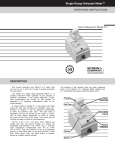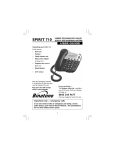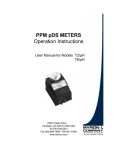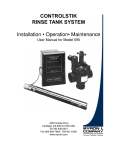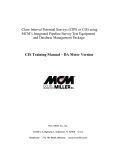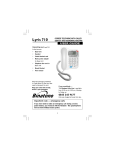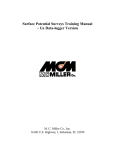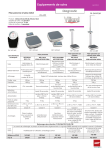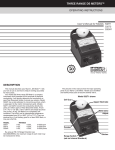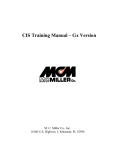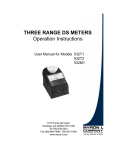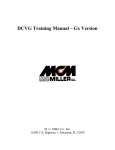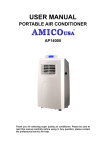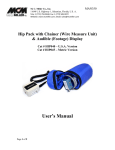Download Agri-Meter Manual
Transcript
AGRI-METERS Operation Instructions User Manual for Models AG-5 AG6/PH 2450 Impala Drive Carlsbad, CA 92010-7226 USA Tel 760-438-2021 Fax 800-869-7668 / 760-931-9189 www.myronl.com pH/Conductivity Instrumentation Accuracy • Reliability • Simplicity DESCRIPTION This manual describes your Myron L Agri-Meter, tells you how to use it, and how to keep it working accurately for many years. Myron L AG-5 and AG6/pH Agri-Meters are compact, light-weight, self-contained conductivity and conductivity/pH meters. They contain a built-in sample cell cup and, in the case of the AG6/pH, a replaceable pH sensor. Both Agri-Meters have dials cailibrated in millimhos. The AG6/pH dial is also calibrated in pH units. It will quickly determine the conductivity and pH of almost any solution. Both are 3.4" x 4.5" x 4.0" (85 x 129 x 126mm) and weigh less than one pound (.45kg). Agri-Meters are completely self-contained. pH and conductivity readings are automatically temperature compensated from 50° to 160°F ( 10° to 71° C). They are powered by a 9 volt transistor battery good for at least 2000 tests, or one year shelf life. MODEL CONDUCTIVITY pH RANGE RANGE AG-5 0-5 millimhos AG6/pH 0-5 millimhos 2-12 pH ACCURACY: (Both Models) CONDUCTIVITY: ±2% of full scale pH: ±0.2 pH units (AG6/pH only) REPEATABILITY: (Both Models) ±1% The pictures in this manual show the major operating parts of your Myron L Agri-Meter. Handle your Agri-Meter and identify these parts to become familiar with it. IMPORTANT: The pH sensor in your AG6/pH Agri-Meter has a limited life much like a battery. Sensor longevity is affected both by the types of solution tested and care given your meter. pH sensors are user replaceable. See MAINTENANCE for additional information. USING YOUR METER SOIL TESTING CONDUCTIVITY MEASUREMENT 1. Rinse the celI cup three times with the sample you want to test. (For very hot or very cold samples see TEMPERATURE COMPENSATION below.) NEVER FILL THE CELL BY DIPPING THE METER INTO WATER! 2. Fill the cell with another sample to at least 1/4" (6mm) above the upper electrode. 3. Press the black button. 4. Read the conductivity in millimhos indicated by the pointer on the dial's black scale. 5. (AG-50NLY) If the pointer goes off the scale to the right try RANGE DOUBLING (see FIELD CALIBRATION). NOTE: When you are finished with the meter, RINSE THE CELL CUP with clean water, preferably distilled or deionized. CONDUCTIVITY AND pH 1. Collect samples which are representative of the area you are testing. Avoid the upper half inch or so, as salts accumulate there because of the surface evaporation. 2. If you have the time, dry the sample. Place it on a paper towel or clean surface and allow it to dry. Rapid drying such as in an oven is not recommended since some nutrients may be vaporized. 3. When using tap water to dilute soil, test the conductivity of the water alone. This figure will be subtracted from the conductivity value of the soil/water mixture solution. It is not necessary to measure the conductivity of deionized or distilled water as it is not high enough to affect the mixture's final conductivity reading. 4. If using the Myron L Soil Test Kit, place the dried soil sample in the smaller vial to either the 2:1 or 5:1 soil line. A 2:1 water-tosoil ratio is usually sufficient. However, organic media such as peat moss need a 5:1 water-to-soil test solution. NOTE: If you are not using the Myron L Soil Test Kit, mix 3 oz. (by volume not weight) of dried soil and 6 oz. water in a container. Organic media use a 5:1 water-to-soil ratio. 5. Pour the measured soil sample into the larger vial. 6. Twice fill the smaller vial with water to the upper line and pour it into the vial containing soil. IMPORTANT: MUST BE DONE TWICE. 7. Cover the large vial with the cap provided and shake vigorously to dissolve all soluble salts. 8. Let stand at least 45 minutes to 1 hour. If possible, let stand overnight to allow complete settling out of suspended particles. 9. Decant off the water into another container or directly into the Agri-Meter cell cup. Filter paper or cloth may be used for additional filtration. Paper towels can alter both the conductivity and pH of the sample, and should not be used as filters. 10. Rinse the cell cup with this sample twice. If using Model AG6/pH be sure to sharply shake out samples to clear the pH sensor chamber. NOTE: If you are also planning to perform the Alkalinity test (see below), save the rinse samples for that test. 11. Fill the cell cup a third time. Press the black button for conductivity (salinity) reading on the black scale. If tap water was mixed with soil, remember to subtract the conductivity reading taken before mixing. The difference is the soil conductivity. If you need assistance in determining correct salinity limits or concentrations contact your fertilizer supplier consultant, or university. 12. For model AG6/pH, press the red button and read pH on the red scale. pH MEASUREMENT (AG6/pH ONLY) 1. Obtain sample to be tested, if necessary, heat or cool it to between 50° and 160°F (10° - 71°C). 2. Remove the pH compartment cap and sharply shake out any liquid. 3. Pour or squirt the sample into the built-in cell cup, especially the small pH compartment. Shake out and repeat three times with the sample to be tested. These may be the same rinsings used to condition the cell forthe conductivity measurement. 4. Press the red button. The pointer immediately indicates the pH of the sample on the red scale. If the pointer drifts wait approximately 30 seconds and press the button again to obtain a stable reading of pH. If drifting continues, the electrode may be coated with a film. Use a liquid cleanersuch as Windex™ or Fantastic™ to clean the pH sensor bulb. 5. Rinse both pH and conductivity parts of the cell with clean water. LEAVE SOME LIQUID IN AND RECAP THE pH COMPARTMENT. TEMPERATURE COMPENSATION: For very hot or very cold solutions let the three rinse samples each remain in the cell for several seconds, then immediately fill the cell with the sample you want to test. This allows the automatic temperature compensation feature time to work properly. CAUTION ALWAYS rinse the cell cup with pure water immediately after use or cleaning. This will prevent the build-up of unwanted deposits and possible contamination of the sample. DO NOT use with samples hotter than 160°F (71°C). The readings WILL NOT be accurate. DO NOT splash solvents such as lacquer thinner, acetone, benzene or chlorinated solvents on the plastic case. DO NOT fix or modify the meter. That will void your warranty. See SERVICE for details or consult Myron L Company. DO NOT DIP THE INSTRUMENT INTO WATER. If water does get inside the instrument, see MAINTENANCE for instructions on drying it. ALWAYS store your pH sensor wet and with the cap on (AG6/pH ONLY). DO NOT test solutions which could damage the pH sensor. See MAINTENANCE (AG6/pH ONLY). DO NOT store meter in direct sunlight. TESTING ALKALINITY 1. Pour a few drops of the sample water and one of the Alkalinity Test Tablets into the Alkalinity Test Vial. 2. Cap the vial and swirl the sample until the tablet completely dissolves. The solution should turn a deep violet color. 3. Uncap the vial and gradually add sample water, agitating to keep the solution well mixed. Continue this until the sample suddenly turns green. 4. Read the alkalinity in ppm by comparing the solution level to the scale on the side of the vial. NOTE: Thoroughly rinse the Alkalinity Test Vial with clean water after each test. CALIBRATION/FIELD CALIBRATION MAINTENANCE/ACCESSORIES CONDUCTIVITY STANDARD SOLUTIONS: A Standard Solution has a known conductivity value. Your meter was calibrated at the factory using Myron LCompany 442-3000 Standard Solution. You can keep your meter accurate by using the same Standard Solution. How often you calibrate your meter depends on how much you use it. For once a day use, recalibrate it every three months. CHECKING CONDUCTIVITY CALIBRATION 1. Test a sample of Myron L 442-3000 Standard Solution. CAUTION: Throw away the Standard Solution as you use it. Don't put the used samples back in the bottle. 2. If the Agri-Meter does not indicate 3.9 millimhos (equivalent to 3900 micromhos), first clean the cell. For directions on how to do this see CELL CUP inside. Rinse the cell thoroughly and test the Standard Solution again. If the Agri-Meter still does not indicate the correct value, recalibrate it as described below. TO RECALIBRATE CONDUCTIVITY 1. Remove the bottom cover using fingernails or a small screwdriver to loosen the front or rear edge. Identify the Conductivity Calibration Control so you can find it by touch while calibrating. Model AG6/pH also has two pH Calibration Controls. See photo below for details. 2. Test another sample of the 442-3000 Standard Solution (be careful to not splash solution inside the meter). 3. Adjust the Conductivity Calibration Control until the meter indicates 3.9 millimhos (3900 micromhos). NOTE: Agri-Meters may not be calibrated to read parts per million. 4. (AG-5 ONLY) Press the red button. 5. (AG-5 ONLY) Compare the meter reading to the INTERNAL STANDARD value on the meter's bottom label. If they are noticeably different, mark the new value in place of the old one. BATTERY CHECK (AG-5): Press the red "S" button. Adjust the Calibration Control to maximum (see FIELD CALIBRATION). If the pointer reads less than full scale (5 millimhos) the battery should be replaced. BATTERY CHECK (AG6/pH): The AG6/pH has a battery indicator glow light visible through the small hole on the lower right-hand corner of the meter face plate. If this light fails to glow when the black button is pressed, replace both batteries. BATTERY REPLACEMENT: To replace each battery detach the battery connector. Pull on the plastic strap to remove the battery. Replace with fresh zinc carbon or alkaline 9 volt battery. Reinsert the plastic strap to secure battery. CELL CUP: Self-conditioning of the built-in electrodes occurs each time the button is pressed with a sample in the cell cup. This ensures consistent results each time. With some samples a small downward swing of the pointer is a result of this conditioning action. This action is powerful and removes normal films of oil and dirt. However, if very dirty samples - particularly scaling types - are allowed to dry in the cell cup, a film will build up. This film reduces accuracy. When there are visible films of oil, dirt, or scale in the cell cup or on the electrodes, scrub them lightly with a small brush and household cleanser. Rinse out the cleanser and the meter is ready for accurate measurements. pH SENSOR: The unique pH electrode in your AG6/pH is a nonrefillable combination type which features a porous liquid junction (covered by U.S. Patent No. 4128468). It should not be allowed to dry out (see pH MEASUREMENT). If it does, the sensor can sometimes be renewed by soaking in a saturated potassium chloride (KCI) solution for several days. "Drifting" can be caused by a film on the sensor bulb. Use a liquid cleaner such as Windex™ or Fantastic™ to clean it. The sensor bulb is very thin and delicate. Excessive pressure during cleaning may break it. Leaving high pH (alkaline) solutions, such as 10 buffer, in contact with the pH sensor for long periods of time can damage it. Rinsing such liquids from the pH compartment and moistening it with 4 buffer or tap water will extend its useful life. Samples containing chlorine, sulphur, or ammonia can "poison" any pH electrode. If it is necessary to measure the pH of any such sample, thoroughly rinse the pH sensor with clean water immediately after taking the measurement. Any sample element which will reduce (add an electron to) silver, such as cyanide, will attack the reference electrode. Replacement sensors are available only from the Myron L Company or our authorized distributors (see ACCESSORIES). WATER INSIDE THE METER Your Myron L meter is a rugged instrument and will withstand water exposure around its cell, meter movement, and switches. However, care shouId be taken to keep water from leaking in around the bottom cover. It is not sealed (to prevent condensation from forming). If the water is relatively clean (i.e., tap water or better), and there are only a few drops inside the meter, dry it as described below. Large amounts of water, or corrosive or very dirty solutions will almost certainly damage meter movement or electronics. Such meters should be returned to the Myron L Company for repair. To dry your meter: 1. Shake excess water out of the inside of the meter. 2. Dab the exposed surfaces dry with an absorbent cloth or tissue. Avoid pushing any water into the Calibration Controls or the switches. 3. Air dry the meter in a warm area with the bottom cover off. Allow several hours for thorough drying. If the water entered through a leak in the case or cell, or if the instrument shows erratic readings or other unusual behavior, return it to the Myron L Company for servicing. FIELD CALIBRATION NOTE: The feature described below is on the AG-5 only. It is intended as a quick field calibration check, or for using the range doubling technique. It is not replacement for calibration with Standard Solution. INTERNAL STANDARD: Your AG-5 has an INTERNAL STANDARD value on the bottom cover of each meter. Use it between normal calibrations as a field check of your meter's accuracy. To verify your meter's calibration: 1. Press the red button. 2. If the reading matches the lNTERNAL STANDARD value on the bottom label, yourAG-5 is in calibration. If not, see FIELD CALIBRATION next. FIELD CALIBRATION (AG-5 only) 1. Remove the bottom cover using fingernails or a small screwdriver to loosen the front or rear edge. 2. Press the red button and adjust the Conductivity Calibration Control until the meter reading is the same as the INTERNAL STANDARD value. NOTE: If the meter will not adjust to the INTERNAL STANDARD value the battery should be replaced. See MAINTENANCE below. 3. Replace the bottom cover. RANGE DOUBLING (AG-5 only) 1. Remove the bottom cover. 2. While pressing the red button, adjust the Conductivity Calibration Control until the meter reads one-half the INTERNAL STANDARD value shown on the bottom label. For example: If the INTERNAL STANDARD value is 4.2. adjust the Conductivity Calibration Control until the reading is 2.1. 3. Test your sample (take care to keep the inside of the meter dry). Multiply by two the reading of the sample tested. For example: If the indicated conductivity is 3.2 millimhos, the actual value of the sample tested is 6.4 millimhos (3.2 x 2). NOTE: After completing tests requiring range doubling reset the Conductivity Calibration Control to its INTERNAL STANDARD value and replace bottom cover. STANDARD BUFFER SOLUTIONS (AG6/pH only) All pH sensors "drift" and decrease in strength as they age. pH meters have two Calibration Controls to compensate for those effects. ZERO adjust corrects for "drift" of the pH sensor's response to neutral pH solutions. GAIN adjust amplifies the signal from the pH sensor for accurate readings of other pH values. Use pH standard buffer solutions to calibrate the pH function onyourAG6/pH. The recommended values are 4, 7, and 10. For greatest accuracy, adjust with the buffer closest in pH to the samples to be tested. pH ZERO ADJUST (Frequency: weekly) Test by rinsing and refilling the AG6/pH cell cup with 7 buffer and pressing the red button. The meter should indicate 7 on the red scale. If it is necessary to calibrate Zero, perform the following steps: 1. Remove the bottom cover using fingernails or a small screwdriver to loosen the front or rear edge. 2. Refill cell cup with 7 buffer (see pH MEASUREMENT for proper procedure). 3. Press the red button and turn the pH Zero control until the needle indicates 7. 4. Recap the pH compartment and replace the bottom cover. pH GAIN (SLOPE) ADJUST (Frequency: bi-monthly) The Gain should be calibrated approximately once every eight weeks. The Gain control is used with 4 and 10 buffers. NOTE: Never adjust the Gain control without first adjusting Zero Test by rinsing and refilling the AG6/pH cell cup with 4 or 10 buffer and pressing the red button. The meter should indicate the buffer value on the red scale. If it is necessary to calibrate the Gain, perform the following steps: 1. Remove the bottom cover. 2. Rinse and fill the pH compartment with 4 buffer and press the red button. Adjust the Gain control until the needle indicates 4. 3. Rinse three times and test with 10 buffer. If adjustment is necessary, adjust to only half way between the initial 10 buffer reading and 10. 4. Retest the 4 and 10 buffers. If, after this, the 4 and 10 buffer readings are not less than one division from 4 and 10, the sensor is deteriorating and should be replaced. The sensor should also be replaced if the Gain control cannot make the pointer reach either 4 or 10. DO NOT store the meter with 10 buffer still in it (see MAINTENANCE). ACCESSORIES CONDUCTIVITY STANDARD SOLUTIONS YourAgri-Meter has been factory calibrated with a Standard Solution of 3.9 millimhos (3900 micromhos) conductivity. You can keep your meter accurate by using this same Standard Solution. All Myron L Company Conductivity Standard Solutions are within 1.0% of Potassium Chloride reference solutions. The concentrations of the reference solutions are calculated from data in the International Critical Tables, Vol. 6. pH STANDARD BUFFER SOLUTIONS: Ready to use, Myron L Company pH buffer solutions are mold inhibited and accurate to within +0.06 pH units @ 25°C. They are traceable to National Bureau of Standards certified pH references and are color-coded for instant identification. RECOMMENDED STANDARD SOLUTIONS MODEL/FUNCTION AG6/pH CONDUCTIVITY pH ZERO pH GAI N AG-5 CONDUCTIVITY SOLUTION NUMBER WARRANTY & SERVICE Myron L Agri-Meters, excluding the pH sensor, have a two-year warranty. The pH sensor has a 6 month limited warranty. If an instrument fails to operate properly, check the batteries, calibrations, and cleanliness of the pH sensor bulb. If it still fails to properly function, return it prepaid to the Myron L Company. If in the opinion of the factory, failure was due to materials or workmanship, repair or replacement will be made without charge. A reasonable service charge will be made for diagnosis or repairs due to normal wear, abuse or tampering. This warranty is limited to the repair or replacement of the Myron L Agri-Meter only. The Myron L Company assumes no other responsibility or Liability. 442-3000 (3.9 millimhos) 7 buffer 4 buffer 10 buffer 442-3000 (3.9 millimhos) PORTA PAK Carrying Case for use with all Myron L portable meters is foam-lined and molded of sturdy ABS plastic. REPLACEMENT pH SENSORS Order Model RPY for AG6/pH Agri-Meters. When ordering, be sure to include the model and serial number of your meter to ensure receiving the proper type. Complete installation instructions are provided with each replacement sensor. ORDERING To order accessories contact your nearest stocking distributor, or the Myron L Company. pH Conductivity Instrumentation Accuracy • Reliability • Simplicity Printed in U.S.A. Specifications subject to change without notice 2450 Impala Drive Carlsbad, CA 92010-7226 USA Tel 760-438-2021 Fax 800-869-7668 / 760-931-9189 www.myronl.com © Myron L Company 2001 (W)







